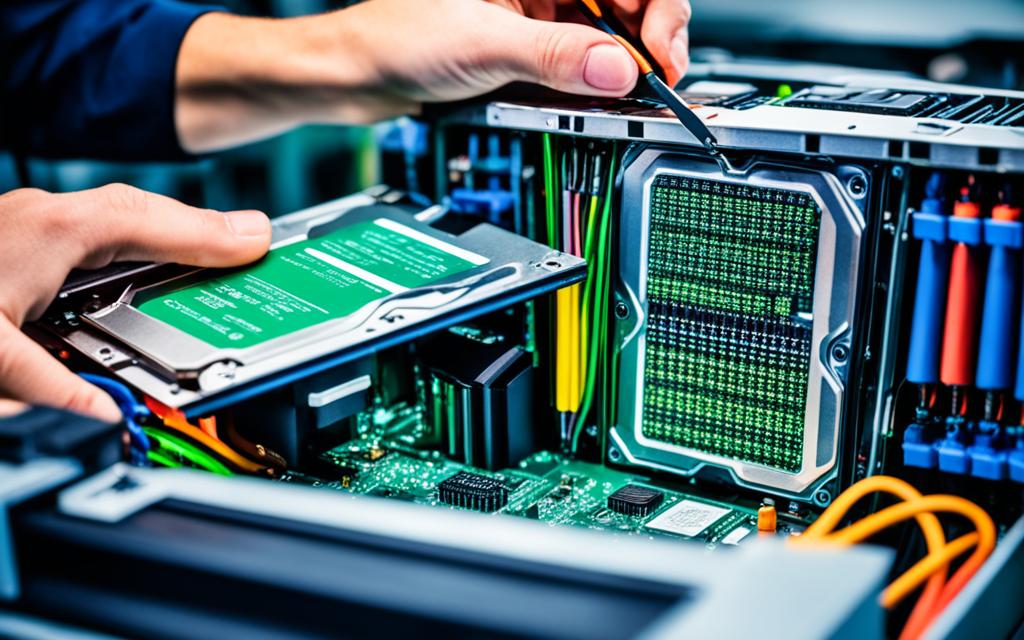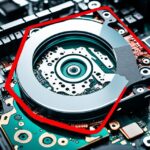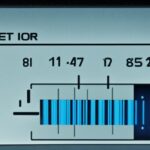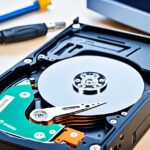Table of Contents
In the tech world, keeping your data safe is top priority. Checking an HDD for bad sectors keeps your data secure. Bad sectors might show up from things like sudden power offs, dust, or viruses. These issues can cause a lot of data loss.
Understanding how to check your hard drive is key for everyone. This article will help you find bad sectors, know when a hard drive might fail, and how to test it. These steps will protect your information and improve your hard drive’s performance. By learning the right tools and steps, you can stop bad sectors from causing a total hard drive crash.
It’s important to act early and learn about HDD testing. By doing so, you protect your data integrity. Don’t wait until it’s too late12.
Key Takeaways
- Testing for bad sectors is vital for maintaining data integrity.
- Common causes of bad sectors include improper shutdown and malware attacks.
- Symptoms of bad sectors include system crashes and corrupted files.
- Utilising tools like Command Prompt can effectively diagnose and repair issues.
- Regular maintenance and checks can prevent excessive bad sectors.
- Backing up your data is crucial in case of hard drive failures.
Understanding Bad Sectors
It’s essential to know about bad sectors to keep your hard drive in good shape. Bad sectors are part of the hard drive that can’t store data anymore. This happens after damage or corruption. Things like turning off your computer the wrong way, viruses, or just using it a lot can cause these issues.
Definition of Bad Sectors
Bad sectors are damaged areas on a hard drive. They’re a sign that you might lose data soon. Knowing about them helps you fix problems early. This way, you protect important stuff. There are two kinds of bad sectors we need to watch out for.
Types of Bad Sectors: Physical vs Logical
There are two sorts: physical and logical bad sectors. Physical ones are messed up spots that can’t read or write data anymore because of damage. This could be due to scratches or too much heat. Logical ones, though, have no physical damage. They just don’t work right because of software problems. Tools like DiskGenius3 can fix logical bad sectors by writing over them.
To keep your hard drive healthy, know the difference between these bad sectors. Be aware of how issues like shutting down wrong can cause harm. By learning how to take care of your hard, you can manage your data better.
Signs Your HDD May Have Bad Sectors
Knowing when your hard drive might be failing is key to saving your data. There are signs that show an HDD might have problems. Spotting these early helps you avoid bigger issues later on.
Common Symptoms of a Failing Hard Drive
There are signs to look out for if you think your hard drive is in trouble. These include:
- Abnormal sounds like clicks or grinding.
- Frequent computer crashes that stop your work.
- File corruption messages when you try to open files.
- Notable decreases in performance with usual tasks.
If you notice these signs, it’s time to check your drive. Regular checks keep it running well and extend its life.
The Importance of Early Detection
Finding bad sectors early is critical to prevent data loss. Catching signs early allows for timely repairs. Regular check-ups and staying informed about computer parts helps avoid major issues. It’s crucial to keep an eye on your device’s health.
How to Test HDD for Bad Sectors
It’s crucial to check your HDD for bad sectors to keep it running well. You can use the Windows Error Checking tool and the Command Prompt HDD test for this. These methods help find and fix problems, keeping your data safe.
Using Windows Error Checking Tool
The Windows Error Checking tool makes it easy to find and repair issues. Just right-click the drive in ‘This PC’, choose ‘Properties’, and go to the ‘Tools’ tab. It can spot and fix problems, making your drive more reliable. If it finds bad sectors, act fast to protect your files4.
Employing Command Prompt for HDD Testing
For a deeper check, use the Command Prompt’s ‘chkdsk’ command. It lets you do a thorough scan and control the test. With this, you can spot all kinds of bad sectors. This method gives detailed info, ensuring a complete check5.
| Method | Ease of Use | Level of Control | Repair Capability |
|---|---|---|---|
| Windows Error Checking | High | Basic | Yes |
| Command Prompt | Moderate | High | Yes |
Effective Methods to Repair Bad Sectors
Fixing bad sectors on an HDD is key to keeping your computer healthy. There are many methods to deal with both physical and logical issues. By using the right HDD diagnostics tools, you can fix these problems and keep your data safe.
Utilising Manufacturer’s Diagnostic Tools
Different HDD brands offer their own diagnostic software. For example, Seagate has SeaTools and Western Digital offers WD Data Lifeguard. These programs do thorough scans to find and fix bad sectors. They often have a detailed test feature. This looks closely at the HDD to find any physical or logical mistakes. Using these HDD diagnostics tools helps prevent future problems.
Third-Party Software Options for Repair
There are also third-party programs to help with bad sectors. Tools like AOMEI Partition Assistant and EaseUS Disk Copy are user-friendly. They offer many features, including recovering data. These software to fix hard drive issues fix logical bad sectors and help clone damaged drives. Using the right tools is important for the HDD’s long life and dependable use. Regularly using these programs fixes repair bad sectors and improves how your system runs.
Running regular checks and using the right software makes your hard drive last longer.
Regular Maintenance to Prevent Bad Sectors
Taking care of your HDD regularly is key to keeping it healthy and efficient. This helps stop bad sectors from forming and boosts performance. By looking after your hard drive well, you can make it last longer and work better. Here are some steps to keep your hard drive in the best shape possible.
Best Practices for HDD Care
For proper HDD upkeep, follow these tips:
- Perform routine defragmentation (for HDDs) to optimise file storage.
- Monitor drive health using utilities like SMART to detect any anomalies early.
- Maintain a suitable operating temperature to prevent overheating.
- Regularly clean the drive and its surroundings to keep it free from dust and pollutants.
- Avoid sudden power losses through the use of an Uninterruptible Power Supply (UPS).
Importance of Backing Up Your Data
Backing up data is vital to avoid losing it due to bad sectors or a drive failing. Making regular backups keeps your important information safe. Here’s how you can protect your data:
- Utilise external drives to create physical backups of essential files.
- Employ cloud services to maintain a redundant digital copy of data.
- Establish a regular schedule for backups to ensure up-to-date data preservation.
By following these guidelines for HDD care and data backup, you can greatly lower the chance of bad sectors. This also makes your storage solutions more reliable. Always keep a close eye on your devices. This helps maintain a sturdy and dependable digital workspace8910.
Conclusion
Regular HDD testing is really important. By catching problems early, like bad sectors, you can keep your data safe. This means less chance of losing important files or having your system fail.
Using tools such as AOMEI Partition Assistant and CHKDSK can help fix these issues quickly. It’s part of keeping your hard drive in good shape. Making sure to back up your data regularly also keeps it safe from unexpected problems.
As technology improves, understanding how to look after your hard drive is key. Taking time for HDD tests and managing your data well means you can be worry-free. This summary on HDD testing highlights how crucial data safety is11129.
FAQ
What are bad sectors on a hard drive?
Bad sectors are parts of the hard drive that are damaged and can’t store data anymore. They come from many sources like sudden shutdowns, viruses, or wear and tear. The damage harms the drive’s ability to keep data safe.
How can I tell if my HDD has bad sectors?
If your hard drive is failing, you might hear strange sounds or have your computer crash a lot. You could also see messages about corrupted files and notice it’s getting slower. Spotting these signs early helps avoid losing your files.
What tools are available for testing an HDD for bad or damaged sectors?
You can check for bad sectors using the Windows Error Checking Tool or the ‘chkdsk’ command in Command Prompt. There are also tools from hard drive makers like SeaTools for Seagate drives or WD Data Lifeguard for Western Digital. These can find and help you understand bad sectors.
Can bad sectors be repaired?
Yes, you can mostly fix logical bad sectors with certain software. But, physical bad sectors usually can’t be fixed. You can try repairs with the maker’s diagnostic tools or third-party software.
Q: How often should I check my HDD for bad sectors?
It’s wise to check your hard drive every few months to keep it running well. Early checks can spot issues before they get worse. Doing regular scans helps your hard drive last longer.
What are the best practices for maintaining my hard drive?
To maintain a good HDD, you should defrag it regularly if it’s not an SSD. Make sure it’s at the correct temperature and clean from dust. Watching its health closely can help stop problems.
Why is backing up data important?
Backing up your data shields you from losing it if bad sectors appear or if the hard drive fails. Using external drives or cloud storage for backups ensures you’re covered. It gives you confidence that your data is safe.
Source Links
- https://superuser.com/questions/1247075/how-do-i-find-bad-sectors-on-my-hdd-when-windows-10-native-programs-apps-service – How do i find bad sectors on my HDD when Windows 10 native programs/apps/services says there are none?
- https://www.diskpart.com/articles/test-bad-sectors-hard-drive-3690.html – How to Test Bad Sectors on Hard Drive or SSD [3 Methods]
- https://www.minitool.com/backup-tips/bad-sectors-on-hard-drive.html – What to Do If I Find Bad Sectors on Hard Drive in Windows 10/8/7? – MiniTool
- https://www.diskgenius.com/resource/check-fix-bad-sectors-hard-drives.html – HDD Bad Sector: Check and Repair Bad Sectors on Hard Disks (3 Ways)
- https://macrorit.com/disk-surface-test/check-bad-sectors.html – 3 Ways to Check Bad Sectors For Hard Drive And SSD
- https://www.easeus.com/disk-copy/clone-resource/repair-a-bad-sector-in-windows-10-8-7.html – Repair Bad Sector: How to Fix Bad Sectors on HDD in Windows 10/8/7
- https://www.auslogics.com/en/articles/how-to-fix-bad-sectors-on-a-hard-drive/ – How to Fix Bad Sectors on a Hard Drive
- https://www.howtogeek.com/173463/bad-sectors-explained-why-hard-drives-get-bad-sectors-and-what-you-can-do-about-it/ – Bad Sectors Explained: Why Hard Drives Get Bad Sectors and What You Can Do About It
- https://www.arysontechnologies.com/blog/hard-disk-bad-sector-common-causes-and-solutions/ – Bad Sector in Hard Disk – Common Causes and Know Solution to Fix It
- https://www.makeuseof.com/tag/what-are-bad-sectors-and-how-can-you-fix-them-part-1/ – What Are Bad Sectors And How Can You Fix Them?
- https://www.diskpart.com/articles/how-to-remove-bad-sectors-from-hard-disk-permanently-1881.html – How to Remove Bad Sectors from Hard Disk Permanently
- https://www.dell.com/support/kbdoc/en-in/000179003/understanding-and-troubleshooting-your-hard-drive-hdd-or-ssd – Understanding and Troubleshooting Hard Disk Drive or Solid-State Drives on Dell Computers












